Japanese ingenuity and design have fascinated the world in a variety of fields and arts, from applications of origami techniques in engineering, to the amazing multi-functional washlet toilet. Today, we would like to introduce you to another incredible invention used around this time of year when cherry blossoms bloom—the jūbako.
A Japanese-style picnic basket
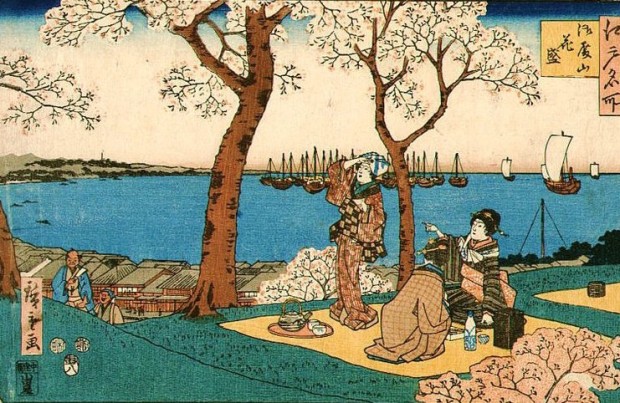 Gotenyama Park from the One Hundred Famous Places of Edo series by Hiroshige Ando.
Gotenyama Park from the One Hundred Famous Places of Edo series by Hiroshige Ando.
In the beginning, the ohanami tradition of flower viewing still practiced today started as a banquet for the gods among the gorgeous mountain cherry trees in spring. Good food and alcohol were offered in hopes for an abundant rice harvest. However, by the time of the eighth shōgun, Tokugawa Yoshimune (1684-1751), ohanami goers would hold banquets beneath the flowering branches to drink and enjoy poetry as a seasonal leisure activity. In this print we can see a group enjoying some tea and refreshments at Gotenyama Park.
But how did they transport their food?
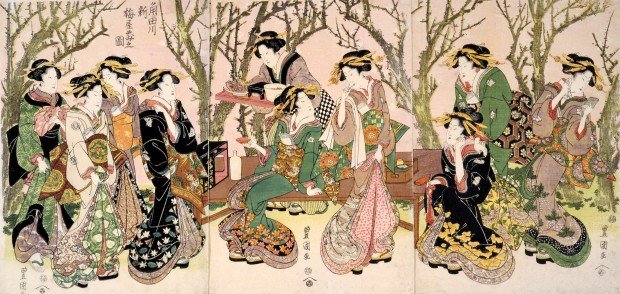 Utagawa Toyokuni’s triptych “New plum at the Sumida River” circa 1789-1801, Edo Tokyo Museum. Image: Tokyo Metropolitan Foundation for History and Culture Image Archive
Utagawa Toyokuni’s triptych “New plum at the Sumida River” circa 1789-1801, Edo Tokyo Museum. Image: Tokyo Metropolitan Foundation for History and Culture Image Archive
On their outings to famous cherry blossom-viewing spots, people would bring along multi-tiered food boxes known as jūbako. Examples can be seen in the above woodblock print by Utagawa Toyokuni.
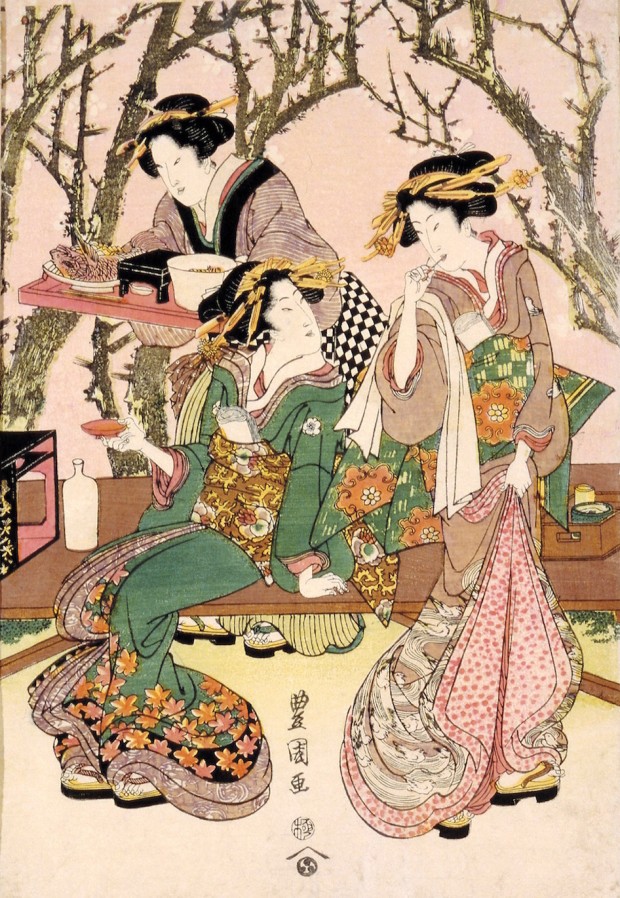 Center sheet of Utagawa Toyokuni’s triptych “New plum at the Sumida River” circa 1789-1801, Edo Tokyo Museum. Image: Tokyo Metropolitan Foundation for History and Culture Image Archive
Center sheet of Utagawa Toyokuni’s triptych “New plum at the Sumida River” circa 1789-1801, Edo Tokyo Museum. Image: Tokyo Metropolitan Foundation for History and Culture Image Archive
These stacked bentō-like boxes were not only convenient and compact ways to transport both food and eating utensils, but also served as a fashionable accessories. Jūbako featured many examples of Japanese artisanal prowess from gorgeous lacquerware and goldwork to joinery and carpentry. The aesthetic sense of Edo’s artisans manifest in the decorative ohanami jūbako.
What exactly do jūbako contain?
Everything necessary to enjoy a feast outside can be found within the compartments of a jūbako! Though similar to a picnic basket, they are a little more complex. A glossy jūbako is like a universe unto itself thanks to its many features!
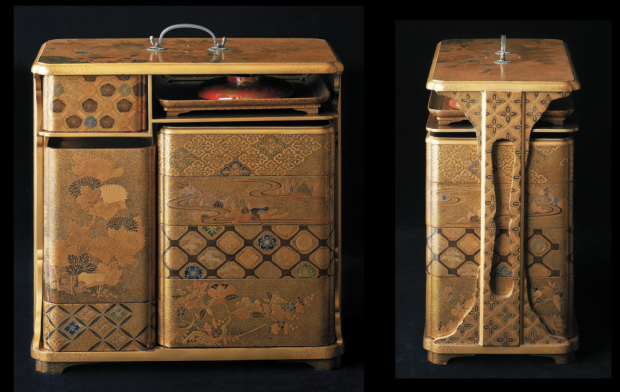 The front and side view of an ohanami jūbako in possession of the Zohiko Urushi Museum in Kyoto. Photographed by Hiroshi Abe.
The front and side view of an ohanami jūbako in possession of the Zohiko Urushi Museum in Kyoto. Photographed by Hiroshi Abe.
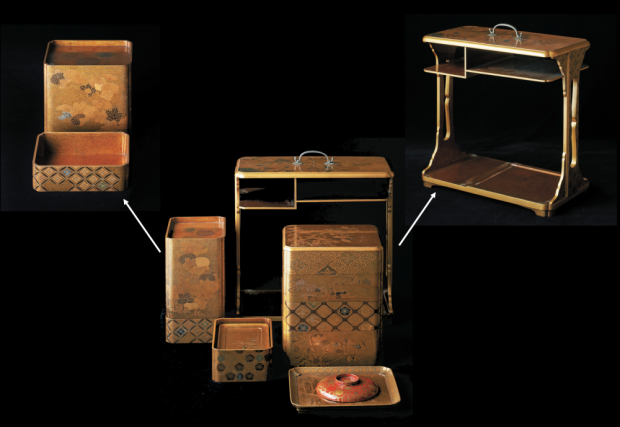
Within the light and compact design, almost no extra space can be found when a jūbako is packed. The minimalism of a jūbako’s design deserves attention. This particular one was made around the middle of the 18th century and is an early example of an ohanami jūbako. It comprises of 7 sections and a total of 20 pieces, yet only measures 30 centimeters in height. Once removing the interior pieces, you will discover a decanter, sake cup, and small plates aside from larger food boxes. Each component boasts a shiny coat of lacquer with elaborate gold and silver-leaf details in addition to flower and brocade-like patterns. Any feast will feel all the more sumptuous with this type of tableware!
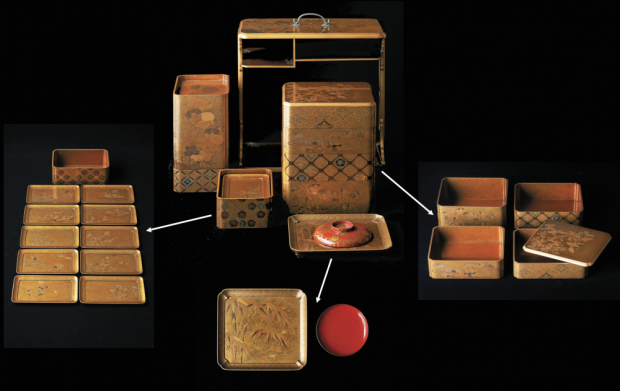
Due to the usage of the chrysanthemum flower crest throughout this jūbako, we can guess that this jūbako belonged to a person of importance within the Imperial Court.
What kind of food was stored and served in ohanami jūbako?
According to the ohanami foods section in an Edo period (1603-1868) cookbook, the first layer consisted of 9 foods including young sweetfish, cuts of sweetened egg omelette, bamboo shoots, and freshly budded bracken. The second layer featured steamed flatfish and small sea bream sushi. More fish was served in the third layer such as flounder and Japanese halfbeak sashimi (slices of raw fish) in addition to vinegared seaweed and vegetables. Finally, the fourth layer held sweetened beans, buns, and other sugary delicacies.
What do you think? Would you like to trying ohanami?
Read more about how to prepare for a modern-day version of a cherry blossom outing here!
You can see more examples of impressive lacquerware and ohanami jūbako at the Zohiko Urushi Museum in Kyoto, too.












